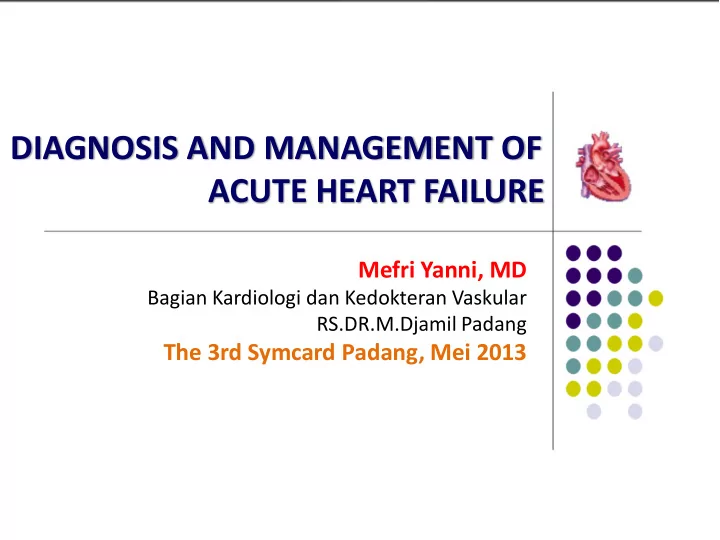

DIAGNOSIS AND MANAGEMENT OF ACUTE HEART FAILURE Mefri Yanni, MD Bagian Kardiologi dan Kedokteran Vaskular RS.DR.M.Djamil Padang The 3rd Symcard Padang, Mei 2013
Outline • Diagnosis Diagnosis Diagnosis • Treatment options Therapeutic goals • Approach to management • Discharge planning Management options Management options Discharge planning
LABS : • Hb value (Anemia?) • Infection marker • Electrolytes • Renal function • Blood glucose • Cardiac enzyme • Blood gas analysis • Throid function – new onset HF
Classification of AHF ESC Guideline. For diagnosis and treatment of Acute and chronic HF. 2008
Assessment of Hemodynamic Profile
Therapeutic Goals in AHF Reduce fluid volume and filling pressures Improve patient Reduce systemic vascular hemodynamic status resistance (SVR) to relief symptoms and stabilize organ function ↑ cardiac output (CO) Reduce neurohormones
Pharmacologic Options
Wet Dry Diuretic Vasodilator A B Warm Warm/Dry Warm/Wet Cold/Dry Cold/Wet Cold C L Fluid Challenge Inotropic drugs
Acute Pulmonary Edema / Congestion Intravenous bolus of loop diuretic 2-2,5 times Yes Oxygen Hipoxemia No Yes Severe Consider iv opiate anxiety/distress No Measure systolic blood pressure SBP 85-110 mmHg SBP < 85 mmHg or shock SBP > 110 mmHg Add non-vasodilating inotrope No additional therapy Consider vasodilator until response assessed ESC Guidelines of Acute and Chronic Heart Failure, 2012
Adequate response to treatment Yes Continue present treatment No Reevaluation patient clinical status No No No SBP < 85 mmHg SpO2 < 90% Urine output < 20 ml/hr Yes Yes Yes • Stop vasodilator • • Oxygen Bladder catheterization • Stop beta-blocker if • Consider NIV to confirm hypoperfused • • Consider ETT Increase dose of diuretic • Consider non-vasodilating • • Consider Invasive Consider low dose inotropes or vasopressor ventilation dopamine • Consider right heart • Consider right-heart catheterization catheterization • Consider mechanical circulatory • Consider ultrafiltration support ESC Guidelines of Acute and Chronic Heart Failure, 2012
Diuretics
Vasodilators Nitroprusside, Nitroglycerin, Nitrate family Work by cGMP mediated smooth muscle relaxation -> vasodilation Decrease myocardial work by afterload and preload reduction May cause hypotension May cause headache
Intravenous Vasodilator in AHF
Inotropic Agents Dobutamin, Dopamine, Milrinone Indication : Peripheral hypoperfusion (hypotension, decrease renal function) with or without congestion Improve cardiac output by directly increasing cardiac contractility Significant proarrhythmic effects May precipitate ischemia ESC, Acute Heart Failure, 2012
Dopamine • Effect dose dependent • In low dose (< 2 ug/kgBW/min) : vasodilatation occurs predominantly in renal, coronary, and cerebral vascular beds. • At doses > 5 g/kgBW/min : will increase peripheral vascular resistance via adrenergic receptors ESC, Acute Heart Failure, 2012
Dobutamine • Clinical action : Positive inotropic Positive chronotropic effects. • Range dosage : 2 – 20 ug/kgBW/min • In low dose < 5 ug/kgBW/min induce arterial vasodilatation • In higher dose induce arterial vasoconstriction ESC, Acute Heart Failure, 2012
Phosphodiesterase Inhibitors • Non beta adrenergic mechanism • Inotropic • Vasodilator • Lusitropy (diastolic relaxation) • Uses – Low cardiac output states – Downregulated/ desensitized – CHF unresponsive to diuretic – Increased SV decreased SVR ESC, Acute Heart Failure, 2012
Cardiogenic Shock • A state of end organ hypoperfusion due to cardiac failure • SBP < 80-90 mmHg or ↓ MAP >30 mmHg • Severe ↓ cardiac index (CI) < 1.8 L/m without support, or < 2.0-2.2 L/m with support ↓ • LVEDP > 18 mmHg, or RVEDP > 10-15 mmHg • Absent or low urine output (< 0.5 ml/kg/h) • Evidence of organ hypoperfusion and pulmonary congestion ESC, Acute Heart Failure, 2012
Vasopressor • Drugs that stimulates smooth muscle contraction of the capillaries & arteries • Cause vasoconstriction & a consequent rise in blood pressure ESC, Acute Heart Failure, 2012
Drugs used to treat AHF ( Inotropes and vasopressor ) ESC, Acute Heart Failure, 2012
Morphine and its analogues • Considered early in patient present with restlessness, dyspnoea, anxiety, chest pain • Morphine induces : Venodilatation Mild arterial dilatation Reduce heart rate • Caution : hypotension, bradycardia, CO2 retention. • Dose : 2,5-5 mg IV bolus (rate 1 mg/min.) repeated if required
Monitoring patient with AHF DAILY MONITORING MORE FREQUENTLY Weight Intake and output • Symptoms Symptoms and • Vital signs • exam Saturation Renal function • Urine output and electrolytes ESC, Acute Heart Failure, 2012
Drug Initiation after stabilization • ACE-I • Beta blocker • Mineralcorticoid receptor antagonist • Digoxin • Device therapy ESC, Acute Heart Failure, 2012
Outline ESC Guidelines Acute and Chronic Heart Failure 2012
Discharge Criteria Near optimal volume status achieved Near optimal oral therapy achieved Transition from iv to oral medications done No IV vasodilators or inotropes x 24 h Oral medication regimen stable x 24 h ESC, Acute Heart Failure, 2012
Discharge Instructions Salt and Fluid restriction diet Discharge medications Patient and family education of risk factors and precipitating factors Follow up clinic visit 3-5 days Weight monitoring Assessment of worsening heart failure Referral for further management ESC, Acute Heart Failure, 2012
Patient Education : What are the symptoms of heart failure ? Think FACES ... • F atigue • A ctivities limited • C hest congestion • E dema or ankle swelling • S hortness of breath
Conclusion Rapid assessment and treatment of AHF could decreased mortality and morbidity rate Management strategies including : – Ensure oxygenation – Reduce pain – Reduce fluid volume – Reduce preload and or afterload – Increase cardiac output – Identify and treat the cause of CHF ESC, Acute Heart Failure, 2012
Recommend
More recommend